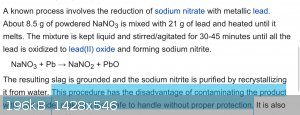Fluorite
Hazard to Others
  
Posts: 132
Registered: 26-12-2018
Location: United Arab Emirates
Member Is Offline
|
|
lead electrodes safety?
So my dad's old emergency battery is fried! Literally
I don't know how can a thunderstorm destroy a fridge + emergency battery!? Can lightning damage refrigerator?
Anyways, I will open this battery using the proper tools :p
First off I know lead is a neurotoxic and does accumulate in the body
But after watching cody's lab videos about concentrating heavy water using electrolysis and TASTING a ml I am confident that lead doesn't dissolve in
water easily
Lead also is a good alternative to silver! Lead chloride is not soluble so it can be used to detect chlorides in solution if there isn't sulfates,
testing hydrogen sulfide using lead acetate
Lead dioxide is a powerful oxidizer and it can be used to make permanganates
But other than how can I use lead electrodes safely? If I make oxygen using lead electrodes can I breath it? Should I put a cotton in the tube to
remove sprays? Btw How does the battery release hydrogen??? Hydrogen and Oxygen gases are produced in cells during normal battery operation and expel
into air through vent caps - Eaton MDSDS and we use the battery indoors obviously -_-
If I make chlorine using electrolysis and bubble it through a NaOH solution can I make useful bleach to clean dishes?
Can I use lead electrodes to make sodium chlorates? And if I filter NaClO3 crystals and add sodium sulfide to remove EVERY traces of lead is it safe
to handle?
making nitrites using lead! can we make Lead free sodium nitrite by adding sodium sulfide and filter it through celite? I know this can be much more
difficult but is this possible? Nile red disposed mercury waste using sodium sulfide
   
[Edited on 13-11-2020 by Fluorite]
|
|
|
Fluorite
Hazard to Others
  
Posts: 132
Registered: 26-12-2018
Location: United Arab Emirates
Member Is Offline
|
|
Hello?
|
|
|
Maurice VD 37
Hazard to Self
 
Posts: 66
Registered: 31-12-2018
Member Is Offline
|
|
Yes, lead is neurotoxic, and does accumulate in the body. But to enter the body, lead may be swallowed, and I doubt you introduce lead compounds in
your food, or that you lick your hands after dismantling a lead battery. It may also enter the lungs if you inhale dimethyllead, which is a liquid
easily vaporized. And indeed this compound was added to usual petrol or gasoline in the 20th century as a stabilizing agent. Now this use is
forbidden, and dimethyllead has been replaced by organic compound containing no lead.
So today there is no easy way of being intoxicated by lead. The yellow pigment lead chromate which was used by van Gogh in the beginning of 20th
century is also forbidden.
The only risk is related to the use of lead pipes for running water if the water contains some vinegar. Because vinegar contains acetic acid that may
attack and dissolve slowly lead. So that the usual running water may contain some lead acetate. There has been intoxications in the previous centuries
due to this origin. But now, lead pipes should have been replaced everywhere. You should be able to check if your drinking water contains some lead.
You mention the heavy water electrolysis that was made with lead equipment. It may contain a tiny amount of lead, but tasting it will make you swallow
such a small amount of lead that it is not dangerous. It is dangerous when you drink the same impure water for months and years. Because its
concentration in lead is extremely small.
As a consequence, you can use your lead electrode without risk, provided you wash your hands and you do not taste your equipment.
If you make an electrolysis of water with lead electrode, you will hardly get any oxygen gas. Instead your lead anode will soon be transformed into
lead dioxide PbO2, which is a brown powder. And if you nevertheless succeed in producing O2 by electrolysis, lead is not the problem. You should take
care not to inhale micro droplets of the electrolyte. Lead is not a risk. It cannot be vaporized by electrolysis. When arriving at the surface of the
electrolyte, Oxygen bubbles produce tiny droplets that may stay suspended in the air. They may be absorbed in the lungs,
Now, if you produce chlorine by electrolyzing NaCl, you will automatically obtain bleach. It is not necessary to collect chlorine and bubble it into
NaOH. Matter of fact, chlorine is produced at the anode, and NaOH is produced at the cathode, If the two electrodes are not two far away, Cl2 and NaOH
react in the solution between the electrodes, and bleach will be slowly produced. That is the usual way of producing bleach in the industry.
To produce sodium chlorate, you simply have to heat bleach up to boiling temperature. Bleach contains sodium hypochlorite NaClO that is automatically
transformed into chlorate NaClO3 at 100°C.
But don't believe that you can obtain sodium chlorate crystals. Sodium chlorate is extremely soluble and will never get deposited even by evaporating
water. The excess of NaCl will crystallize first. The only way of saving chlorate is to add a saturated solution of KCl in the hot solution, and cool
it down. Potassium chlorate is so weakly soluble at room temperature, that it will crystallize in the pure state when the solution made of KCL and
heated bleach is cooled.
Anyway don't add sodium sulfide, as there is no lead in the solution. And sodium sulfide has a painful odor of rotten eggs
|
|
|
|